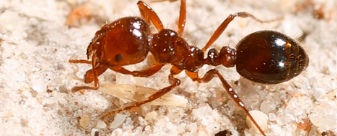What are Fire Ants
Fire ants can be identified by a few distinguishing features.
They are:
copper brown in colour with a darker abdomen
quite small at 2 – 6 mm
found in a variety of sizes within the one nest.

When checking suspicious ant nests gently poke the nest with a long stick and observe the ants that come out.
Be careful not to get too close, as fire ants are aggressive. They swarm when disturbed and have a painful sting.
As summer kicks in with heat, humidity, downpours, and severe storms, fire ants are proving their resilience. Unable to regulate their body temperature, fire ants adapt their nests to survive harsh conditions.

In warmer or dry weather, nests often appear as small, loose soil patches. After rain or in cooler weather, they form larger, more visible mounds.
During heavy rains or floods, fire ants can even create rafts to protect their colony. Worker ants link together, forming air pockets to keep queen and her eggs afloat. However, fast-moving water or prolonged submersion can destroy these rafts and the ants will die.
If your area experiences significant rain or flooding, we encourage you to look for and report any suspect ants or nests within 24 hours of sighting them.
About the National Fire Ant Eradication Program
The National Management Group includes representatives from states, territories and the Commonwealth.
The work done by the Queensland Government’s Fire Ant Suppression Taskforce (FAST) complements our eradication efforts. FAST focuses on equipping all levels of government, industry and communities in areas awaiting planned treatment, with the skills and knowledge to self-manage fire ants on land they own or manage.